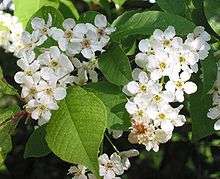Prunus padus
- Not to be confused with Prunus avium, meaning "bird cherry".
| Prunus padus | |
|---|---|
 | |
| Bird cherry flowers | |
| Scientific classification | |
| Kingdom: | Plantae |
| (unranked): | Angiosperms |
| (unranked): | Eudicots |
| (unranked): | Rosids |
| Order: | Rosales |
| Family: | Rosaceae |
| Genus: | Prunus |
| Subgenus: | Padus[1] |
| Species: | P. padus |
| Binomial name | |
| Prunus padus L. | |
 | |
| Distribution map | |
| Synonyms[2] | |
|
List
| |

Prunus padus, known as bird cherry, hackberry, hagberry, or Mayday tree, is a species of cherry, native to northern Europe and northern Asia. It is a deciduous small tree or large shrub, 8–16 m tall, which grows south of the Arctic Circle in the British Isles, Norway, Sweden, Finland, Russia and Ukraine. There are also some trees in France, Spain, Portugal, North Italy and in the Balkans. It is the type species of the subgenus Padus, which have flowers in racemes.
Characteristics
The English name "hackberry"[3] refers to the fruit, which is astringent due to their tannin content.[4]
There are two varieties:
- European bird cherry Prunus padus var. padus, Europe and western Asia.
- Asian bird cherry Prunus padus var. commutata, eastern Asia.
Ecology
The flowers are hermaphroditic and pollinated by bees and flies. The fruit is readily eaten by birds, which do not taste astringency as unpleasant.
Bird-cherry ermine moth (Yponomeuta evonymella) uses bird-cherry as its host plant, and the larvae can eat single trees leafless.
Poison
The glycosides prulaurasin and amygdalin, which can be poisonous to some mammals, are present in some parts of P. padus, including the leaves, stems and fruits.[5]
Uses
The fruit of this tree is seldom used in western Europe, but is commonly eaten farther east.
The black fruits of the tree can be ground down to make flour for culinary purposes.
It was used medicinally during the Middle Ages.
The bark of the tree, placed at the door, was supposed to ward off plague.
It is also sold as an ornamental in North America as a May Day tree.
A taboo on the use of the wood was reported by natives of Advie, in northeast Scotland, being regarded as a "witches tree".[3]
See also
- Taphrina padi - A Pocket Plum gall that occurs on Bird Cherry
References
- ↑ Rehder, A. 1940, reprinted 1977. Manual of cultivated trees and shrubs hardy in North America exclusive of the subtropical and warmer temperate regions. Macmillan publishing Co., Inc, New York.
- ↑ "The Plant List: A Working List of All Plant Species". Retrieved January 27, 2014.
- 1 2 Walter Gregor, "Some Folklore of Trees, Animals, and River-fishing from the N.E. of Scotland" The Folk-Lore Journal. Volume 7, 1889. p. 41.
- ↑ "Bird cherry (Prunus padus)". Science & Plants for Schools (U.K.).
- ↑ N.D.Sargison; D.S.Williamson; J.R.Duncan; R.W.McCance (1996). "Prunus Padus (bird cherry) poisoning in cattle". Veterinary Record. 138: 188. doi:10.1136/vr.138.8.188.
…stems, leaves and fruits of P. padus contain the glycosides prulaurasin and amygdalin…
External links
- Prunus padus - information, genetic conservation units and related resources. European Forest Genetic Resources Programme (EUFORGEN)
| Wikimedia Commons has media related to Prunus padus. |